Get a Customized Website SEO Audit and Online Marketing Strategy and Action Plan

Most webmasters and SEO believe that long tail keywords are a great ranking opportunity and, if utilized properly, can be the difference between ranking well or not ranking.
Although I do not contradict the above statement, I most often come across the wrong concepts that people and SEOs have about long tail keywords. In this article, we will discuss what is categorized as long tail keywords and how identifying them can lead to a golden opportunity for your website or blog for quick traffic gains in the SERP.
AlsoAsked.com is one such website that helps in finding long tail keywords but also helps in finding the semantic relationships between each subtopic which helps in framing the content in blog posts.
But let’s understand long tail keywords very well through the following topics:
- What are long-tail keywords?
- Why are they called long-tail keywords?
- What makes long-tail keywords a gold mine for Ranking?
- How to find long-tail keywords?
- How to effectively use long tail keywords?
What are Long Tail Keywords?
Long-tail keywords essentially search phrases that are longer than two or three words. They are often used to pinpoint what a person is looking for in the search bar. This search keyword is more specific than typing in just “shoe” and is more likely to reveal exactly what the person is looking for.
For example, A person searching for a specific type of “patio chairs” would be more likely to search for “navy blue patio chairs”.
The latter is a long tail keyword since it has a search volume of “90”, much lower than the head term “patio chairs”.
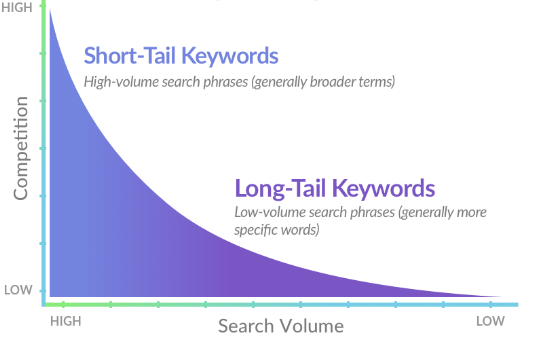
Why are they called Long Tail Keywords?
Contrary to popular belief, the word longtail keywords come from the position of these words in search volume vs no. of keywords plot, also known as the “Search Demand Curve”.
If we plot all of the different search terms happening in Google with their corresponding search volumes, we get a curve like this.
At the “head” of the curve, only a few keywords have search volumes exceeding 100k per month; however, as the curve progresses, we see it reaches a portion containing a very large number of keywords with very low search volumes.
These terms in the top are called head terms, while the tail end containing billions of keywords with low search volume are called long tail keywords.
To be accurate, the search volume distribution of all keywords typed in Google contains 94% long tail keywords. In other words, 94% of all searches happen on long-tail keywords!
This is not a surprise as it is a well-known fact that 15% of all searches in Google are new and do not contain enough competition for ranking.
However, defining long-tail keywords by their word count is a grave error.
The problem is that many one-word keywords receive fewer than 100 searches each month. Additionally, there are keywords with five words or more and hundreds of thousands of searches per month.
Therefore, a keyword’s length does not determine whether it is long-tail. The frequency of that keyword’s searches does.

What makes long-tail keywords a gold mine for Ranking?
Long Tail Keywords are less competitive
This is also logical since long-tail keyword tends to be intent-specific. It requires a lot of content to cover a topic like “What is Bitcoin”, however, a topic like “Does Bitcoin pay dividends” is very specific and perhaps can be answered suitably in 4-5 sentences.
Hence naturally, they tend to be less competitive. The following screenshots further verify this.
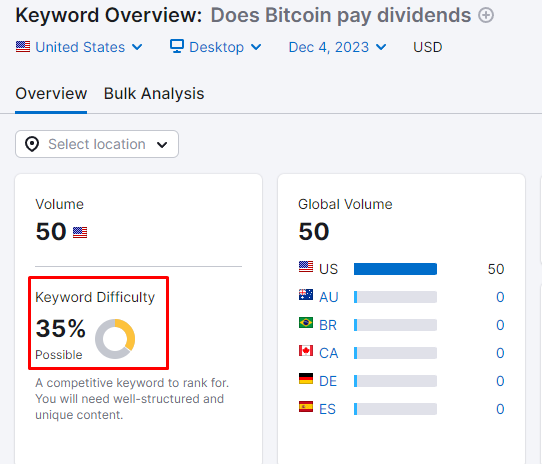
As you can see,” bitcoin”, “mine bitcoin”, and “invest in bitcoin” are very broad topics and one might have to cover a lot of topics to answer the query appropriately. However, check the difficulty rating of the below topics.
The long tail keywords being intent-specific leads to lower competition. Judging by the score, creating a dedicated page targeting these queries and lead to some quick wins in the SERP.
Long Tail Keywords are Intent Specific and hence are easier to address with content
This makes a lot of sense as long tail keywords, as mentioned above, are intent-specific and require a lot less content to address the intent.
Let’s look at the content length for the top-ranking pages for the keyword “how to mine bitcoin.”
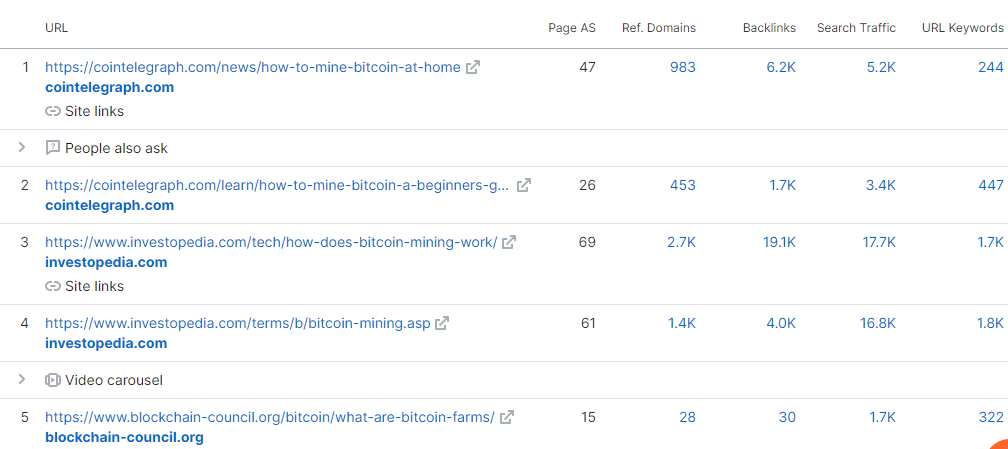
As far as a screaming frog, the word count is “5583” words. Good luck outranking that… 🙂
Let’s do the same for the long tail keyword: “does bitcoin pay dividends.”
As you can see, the word count of the top-ranking result shows to be only “1519” words.
Now that is far easier to beat than the previous one.
Although content length is not the only deciding factor for ranking, it is a pretty good indication of how broad or specific a search term is in terms of its context.
How to find long-tail keywords?
Researching long-tail keywords is a must-have skill for anyone serious about ranking for a new website. Although there are many tools to find long tail keywords, AlsoAsked stands out in several ways.
AlsoAsked.com offers a comprehensive list of long-tail keywords based on the search query entered. Furthermore, the tool is user-friendly and easy to navigate. By entering a search query, the user gets a comprehensive list of long-tail keywords related to the query. For each keyword, the user is given detailed information such as the search volume and difficulty rating.
AlsoAsked.com Review
Let us look at this with an example.
I wanted to create a whole new website regarding patio furniture. As for most niche websites, I have to develop a content plan with a list of keywords and key phrases to expand my topic.
I went to AlsoAsked.com and entered my seed keyword “patio furniture”. Immediately I was presented with a list of related long-tail keywords that are semantically relevant to my original query.
Hence I get tons of different ideas to expand my blog on. Below is a summary of the results. The main head topic is something I would love to rank for, but that topic is competitive.
On the other hand, the subtopics and their branches are much more specific in intent and being long tail will be much easier to rank.
Incorporating these topics and keywords makes me a solid foundation for the whole site and helps make an efficient content/keyword strategy.
Going Deeper with Content with AlsoAsked
It doesn’t end with that; each of the head terms in the created semantic tree can also be expanded into the tree of topics on its own.
We can see more topics if you click on the little “+” signs on each head term on the semantic tree. For example, I can see the keyphrase “What is a good outdoor furniture brand” as a potential topic for a whole new content category. When I clicked on the “+” sign, I was presented with another list of subtopics to expand upon.
Hence one can go deep and create comprehensive content structures for their website using AlsoAsked.com.
The two types of long-tail keywords
Long-tail keywords differ from one another. While some are distinct search queries, others are less popular variations of more common search queries.
The former is often called “topical long-tail keywords.” and the latter is called “supporting long tail keywords”.
Supporting Long Tail Keywords
I’ll give you an illustration to help. Given that there are just 120 monthly searches for “best healthy snacks for dogs,” it is clear that this term is long-tail.
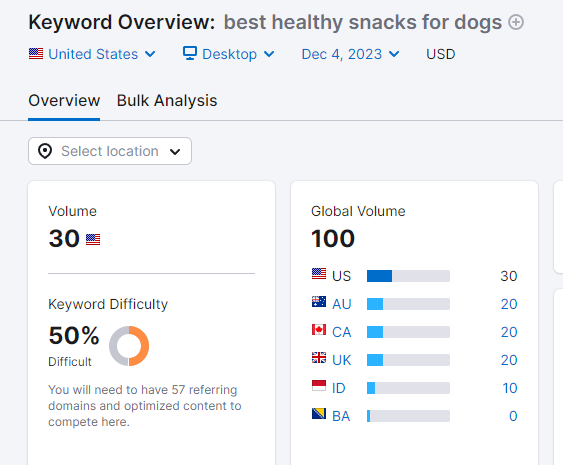
Some other relevant terms are as follows:
You’ll find that the same pages are showing up at the top of Google searches for each of these terms if you search for them individually.
Google is intelligent enough to recognise that even when users search for the same thing, they may use different search terms. In light of this, it rates the same collection of pages for each of these keyword variations.
Accordingly, if your page starts to rank for a well-known search term, such as “healthy dog treats” (6.8k searches), it will also start to rank for all of the long-tail versions of that term. As a result, you don’t need to make separate pages for each long-tail variation. Instead, you should use a single page to target each.
Hence the variations are called supporting long-tail keywords.
Topical Long Tail Keywords
Now let us understand a different search term this time; let’s say “natural sleep aid for dogs” may seem like a variation of the topic “sleep aid for dogs”.
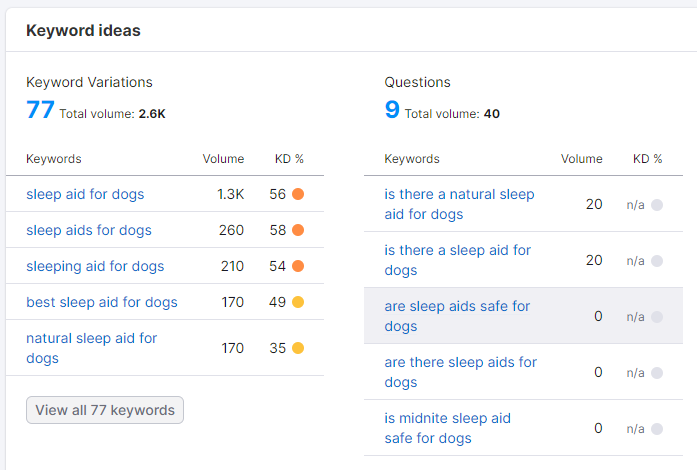
However, one may argue that natural sleep aid is a separate topic since the user might be looking for more natural pharmaceutical solutions for the sleeping problem of dogs rather than a traditional treatment.
Also, looking at the search volume, I believe dedicating an article to this term can win some top rankings in the SERP.
How AlsoAsked.com helps in identifying Supporting and Topical Long tail terms?
The semantic grouping feature of AlsoAsked.com helps identify topical terms from the supporting terms.
For example, in the below pic, the terms in the head positions act as individual topics and the terms at the extreme ends act as supporting variation.
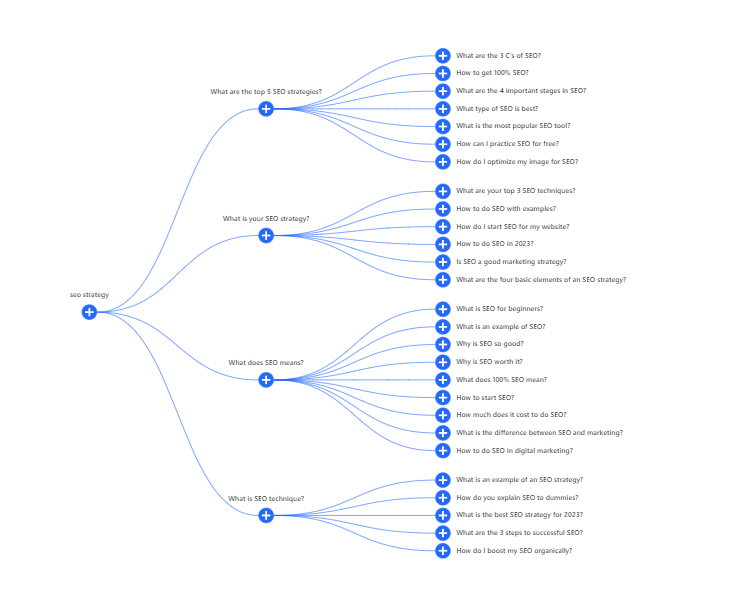
Other Features of AlsoAsked.com
Different plans have different features, but some of the more common ones are as follows:
- Upload a CSV of keywords
- Search by keyword
- Search by country
- Choose a language
- Choose standard or deep search (uses additional credits)
- Export to PNG
- Export to CSV
The system is configured to save and cache each report, allowing you to review it without spending any credits.
However, you can clear the report’s cache to get the most recent data.
Deep Search
Deep search is an optional type available in higher plans that provides a more detailed topic hierarchy. A deep search does cost an extra four credits, but the additional levels of questions you receive are well worth it. I only have the most basic plan, so I can’t provide a screenshot, but you can learn more here.
Final Thoughts
AlsoAsked.com has all the features required to optimize any website with long tail keywords and it empowers an individual to create great contextual and deep content structures.
The power of long-tail keywords is essential for ranking in the modern practice of SEO and AlsoAsked.com brings that power to everyone.

Thatware | Founder & CEO
Tuhin is recognized across the globe for his vision to revolutionize digital transformation industry with the help of cutting-edge technology. He won bronze for India at the Stevie Awards USA as well as winning the India Business Awards, India Technology Award, Top 100 influential tech leaders from Analytics Insights, Clutch Global Front runner in digital marketing, founder of the fastest growing company in Asia by The CEO Magazine and is a TEDx speaker.

